Yellampalli S. (ed.) Carbon Nanotubes - Synthesis, Characterization, Applications
Подождите немного. Документ загружается.


Carbon Nanotube Synthesis and Growth Mechanism
157
perform carbon fiber growth in a temperature range of 600–1200°C at different gas pressures
up to 225 torr (maximum), while the TEM column was maintained at sufficiently low
temperature and pressure suitable for electron microscopy. For acetylene decomposition on
nickel catalyst supported on silica and graphite supports at 600°C, they clearly observed that
the metal particles changed it shape and moved up with a trail of carbon deposit (30–50 nm
diameter). From the changing shape of the metal particle during fiber growth, they assumed
that the catalyst was in liquid phase. The activation energy calculated for this growth was
nearly same as the activation energy of carbon diffusion in liquid nickel; hence they
suggested that carbon diffuses through the bulk metal and the fiber growth rate is diffusion-
controlled. Similar tip-growth process was observed with Fe, Co and Cr catalysts (Baker et
al., 1973). But in the case of acetylene decomposition on bimetallic (Pt-Fe) catalyst, the
catalyst was observed to remain static on the substrate, while the carbon filament went on
growing up. This led them to enunciate a base-growth model (Baker et al., 1975). It was
explained that strong interaction between Pt-Fe and SiO
2
substrate kept the metal particle
anchored to the substrate surface, and carbon precipitation occurred from the free upper
face of the particle. Temperature and concentration gradients were thought to be the main
driving forces for the continued growth dynamics. The filament growth was seen to be
ceased when the particle was fully covered with the carbon cloud, but it could be re-
activated by exposure to either hydrogen or oxygen at higher temperatures (Baker et al.,
1972). Later, however, many scientists reported base-grown CNTs from Fe and Co catalysts
on Si and SiO
2
substrates (Li et al., 1999; Bower et al., 2000). This indicates that the same set
of hydrocarbon, catalyst and substrate may act differently in slightly different experimental
conditions (temperature, pressure, etc.).
In 1984, Tibbetts explained why catalytically-grown carbon nanofibers were tubular.
Because the surface free energy of the (002) basal plane of graphite is exceptionally low, the
free energy required for a filament growth is minimum when graphite is in the form of a
seamless cylinder circumfering the metal. And the inner core is hollow because inner
cylindrical planes of small diameter would be highly strained, energetically unfavorable to
form. He also explained the CNT growth mechanism with a vapor-liquid-solid (VLS) model,
originally formulated for Si, Ge whiskers and many other crystals (Wagner et al., 1965).
Although this model is convincing and acceptable to a great extent, it is often doubted how
Fe, Co, Ni etc. (normal melting point ~1500°C) could be in liquid state within 600–900°C, the
growth temperature of typical CNTs in CVD. Here it is important to note that the melting
point of nanoparticles below 10 nm falls abruptly (Fig. 4). For instance, an 8-nm Fe and Au
particle (or 4-nm Ni particle) can melt at about 800°C. Typical CNT growth temperature
range is 700–900°C, implying that in some cases (>800°C) the catalyst metal may be in liquid
state, while in some cases (<800°C) it may be in solid state. Also, in any experiment, all
particles are not strictly of the same size. So, it is still hard to say on the metal’s state
authoritatively. However, recalling that hydrocarbon decomposition on metal surface is an
exothermic reaction, it is likely that the extra heat generated during hydrocarbon
decomposition helps metal liquefaction to some extent. Hence the opinion of active catalyst
being in liquid phase wins, as reported by many scientists for SWCNT growth (Ding et al.,
2004; Harutyunyan et al., 2005). But then, what about the case of MWCNTs which usually
grow on bigger (>20 nm) metal particles? Bigger particles must be in solid phase; and in
turn, MWCNT would involve a different growth mechanism than that of SWCNT!!
Another reasonable disagreement between the SWCNT and MWCNT growth is on the
existence of temperature gradient inside the metal catalyst. Baker’s explanation of
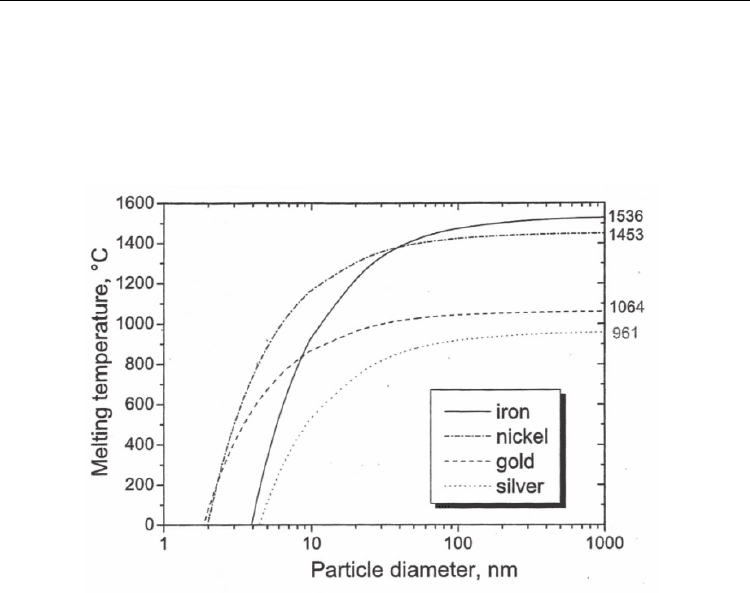
Carbon Nanotubes - Synthesis, Characterization, Applications
158
temperature-gradient driven fiber growth might be applicable to MWCNTs which involve
big catalyst particles. In the case of SWCNTs, however, it is very hard to imagine a
significant temperature gradient within a particle of 1-2 nm. Hence SWCNT growth must be
driven by the carbon concentration gradient during the process. A molecular dynamics
simulation study suggests the possibility of SWCNT growth without any temperature
gradient in the metal (Ding et al., 2006).
Fig. 4. Melting temperature of selected metals as a function of particle diameter. (Moisala et
al., 2003. J. Phys.: Condens. Mater. 15, S3011-S3035. © IOP Publishing Ltd.)
3.2 Mode of carbon diffusion
Another highly-debatable question is whether the so-called diffusion of carbon species
through metal particle is surface diffusion or bulk (volumetric) diffusion. Endo’s group who
extensively carried out benzene decomposition on iron catalyst at 1100°C (Oberlin et al.,
1976), argued that hollow fiber could form only by surface diffusion on the metal particle, as
earlier proposed by Baird et al. (1971). In 2004, Helveg et al. succeeded in observing
MWCNT growth from methane decomposition at 500°C on Ni catalyst in a high-resolution
TEM. They noted that, throughout the growth process, the nickel cluster remained
crystalline with well-faceted shapes (Fig. 5). The graphite layers were found to grow as a
consequence of dynamic interaction between carbon and nickel atoms. ‘Surface atoms’ of the
nickel cluster moved up and down, in and out (continuously changing the metals’ surface
texture) as if they were knitting a graphene sheet out of the surrounding carbon atoms. The
nanocluster shape was periodically changing its shape from spherical to cylindrical, aligning
the graphene layers around them. The authors proposed that the mono-atomic steps on the
cluster boundary played a key role in anchoring carbon atoms and knitting the graphene
network. This observation reveals that the catalyst is in solid phase and the carbon diffusion
is a surface diffusion around the catalyst.
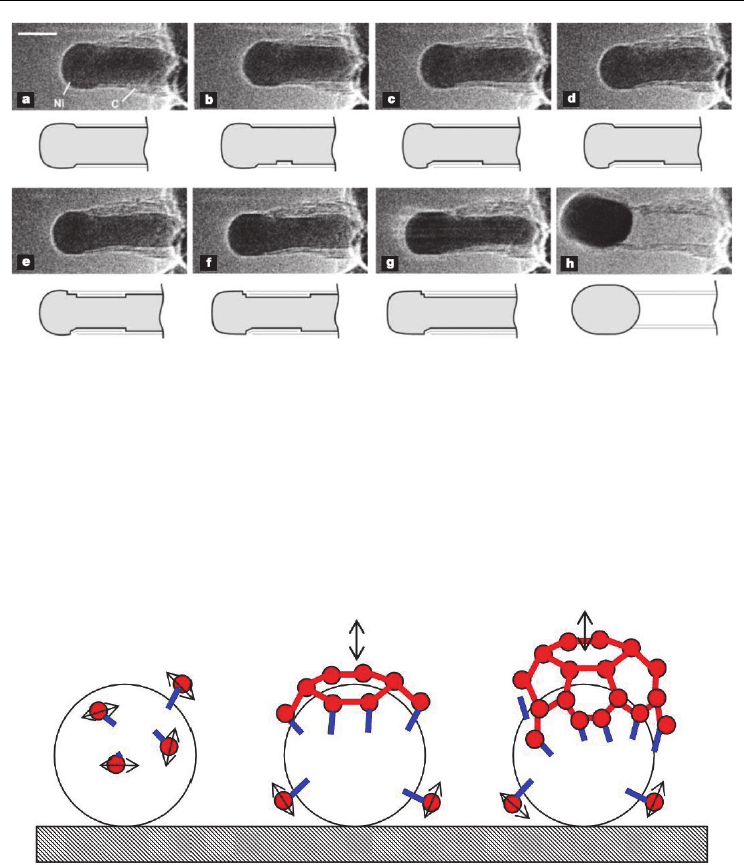
Carbon Nanotube Synthesis and Growth Mechanism
159
Fig. 5. In situ HRTEM image sequence of a growing carbon nanofiber. Images (a–h) illustrate
one cycle in the elongation/contraction process. Drawings are included to guide the eye in
locating the positions of mono-atomic Ni step-edges at the graphene–Ni interface. Scale bar
= 5 nm. (Helveg et al., 2004. Nature 427, 426-429. © Nature Publishing Group)
Later, Raty et al. (2005) reported a molecular dynamics simulation study of the early stages
of SWCNT growth on metal nanoparticles. They showed that carbon atoms diffuse only on
the outer surface of the metal cluster. At first, a graphene cap is formed which floats over the
metal, while the border atoms of the cap remain anchored to the metal. Subsequently, more
C atoms join the border atoms pushing the cap up and thus constituting a cylindrical wall
(Fig. 6).
Fig. 6. Schematic representation of the basic steps of SWCNT growth on a Fe catalyst, as
observed in ab initio simulations. (i) Diffusion of single C atoms (red spheres) on the surface
of the catalyst. (ii) Formation of an sp
2
graphene sheet floating on the catalyst surface with
edge atoms covalently bonded to the metal. (iii) Root incorporation of diffusing single C
atoms. (Raty et al., 2005. Phys. Rev. Lett. 95, 096103. © American Physical Society)
In 2007, Hofmann et al. reported an atomic-scale environmental TEM observation of CNT
growth from acetylene decomposition on Ni particles at 480°C. Figure 7 shows the growth
stage at different times (as mentioned therein) captured from a continuous video recording.
(i) (ii) (iii)
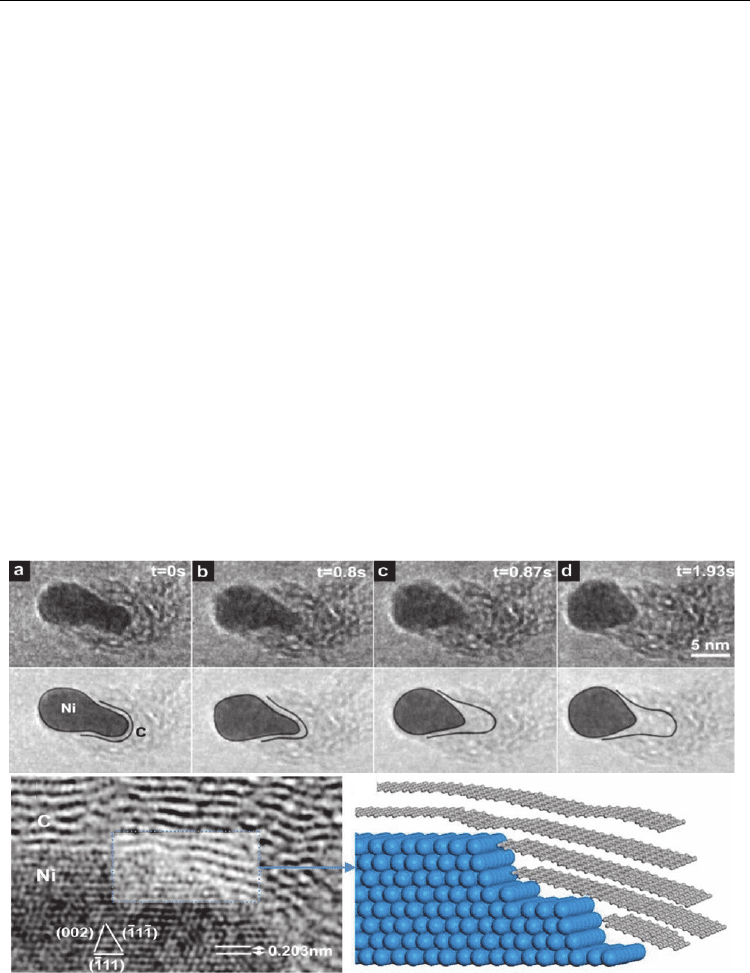
Carbon Nanotubes - Synthesis, Characterization, Applications
160
Initially, the Ni cluster had a round shape which transformed into an elongated shape
(perpendicular to the substrate) surrounded by a thin carbon layer. This elongation was in
contact with the substrate up to 0.8s and suddenly (at 0.87s), the Ni cluster left the substrate
contact and contracted upward taking a round shape and leaving behind a hollow carbon
tube. This elongation and contraction of Ni re-occurred alternately, moving ahead and
leaving behind a bamboo-like MWCNT grown. The inner walls of the tube appeared to
emerge from step-like stages of Ni cluster (see HRTEM and corresponding model in Fig. 7),
suggesting that carbon atoms also diffuse deep inside the Ni cluster and crystallize in the
form of inner tube walls when the Ni cluster moves up (contracts back to round shape at the
CNT tip). This was a MWCNT observation via tip growth model. In another experiment at
615°C, the authors observed SWCNT formation from a small Ni cluster via base growth
model (Fig. 8). Initially, a carbon cap emerged with a diameter smaller than the Ni cluster.
Then, the apex portion of the cluster assumed a cylindrical shape, pushing the carbon cap
off the cluster and forming a SWCNT. Finally, the CNT network expanded upward by itself.
These evidences also explain the general experience that small nanoparticles are crucial for
SWCNT formation. Small metal clusters (1–2 nm) have sharp edges (atomic steps); hence
they possess high catalytic activity and are capable to form high-strain SWCNTs. With the
increasing cluster size, the sharpness of the atomic steps at the cluster boundary decreases
and so does their catalytic activity. Therefore, bigger metal clusters (5–20 nm) form less-
strained MWCNTs. Too big clusters (viz. 100 nm) acquire almost spherical boundary with
no sharp steps; that is why they do not form CNTs at all.
Fig. 7. In-situ TEM image sequence showing a MWCNT nucleation and growth, and
corresponding growth scheme. (Hofmann et al., 2007. Nano Lett. 7, 602-608. © American
Chemical Society)
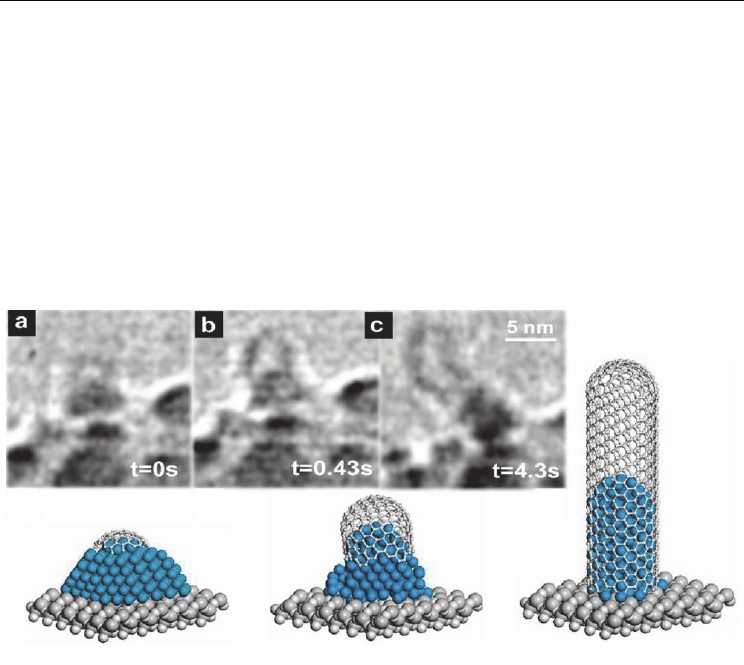
Carbon Nanotube Synthesis and Growth Mechanism
161
Quite intriguingly, however, two months after Hofmann’s (2007) report, Rodriguez-Manzo
et al. (2007) reported an exciting observation of CNT formation in an HRTEM by simply
holding a metal-encapsulated MWCNT at 600°C under electron beam (300kV) for 90 min.
Carbon atoms from the side walls (the existing graphite layers around the encapsulated
metal) got injected into the metal bulk and emerged in the form of new SW, DW and
MWCNTs of smaller diameters coaxial to the original MWCNT (Fig. 9). Such a prolonged
observation of the CNT-growth dynamics (atom-by-atom) clearly evidences that carbon
diffuses through the metal bulk (volume diffusion). Nevertheless, we should note that this
observation was an exclusive case of rearrangement of the carbon-iron ensemble inside a
constrained nanoreactor (the original MWCNT) under high-energy electron-beam
irradiation, a situation far away from usual CVD conditions. Hence such bulk diffusion
cannot be conceptualized as a general CNT growth mechanism.
Fig. 8. In-situ TEM image sequence showing a SWCNT nucleation and growth, and
corresponding growth scheme. (Hofmann et al., 2007. Nano Lett. 7, 602-608. © American
Chemical Society)
In the context of the changing metal shape during CVD, it is pertinent to mention another
aspect of the CNT growth. Many a time we encounter CNTs with their graphene layers
inclined to the tube axis (herringbone or stacked-cup structure). It is puzzling to think how
they form. Keeping in mind that graphite layers grow preferentially on selected crystal
planes of metal, this can be understood as follows. The shape of the catalyst metal cluster
acts as a template for the surrounding graphene layers. Nanoclusters (say, 10–20 nm Ø)
under suitable thermodynamic conditions, tend to form an elongated cylindrical shape (viz.,
3 nm Ø) so that CNTs grow with the graphene layers parallel to the tube axis. Under certain
(different) thermodynamic conditions the metal clusters tend to become pear-shaped, giving
birth to graphene layers parallel to their inclined facets. This usually happens with bigger
clusters (say, 100 nm) or for alloy catalysts (Kim et al., 1992). When it comes to explain how
such open-edged nanographenes are energetically stable, scientists suggest that those
dangling bonds at the edges of the stacked graphite platelets are stabilized with the
hydrogen atoms expelled from the hydrocarbon or from the H
2
supply (Nolan et al., 1998).
Such a fiber is known as graphite whisker, and many people do not consider that as a CNT.
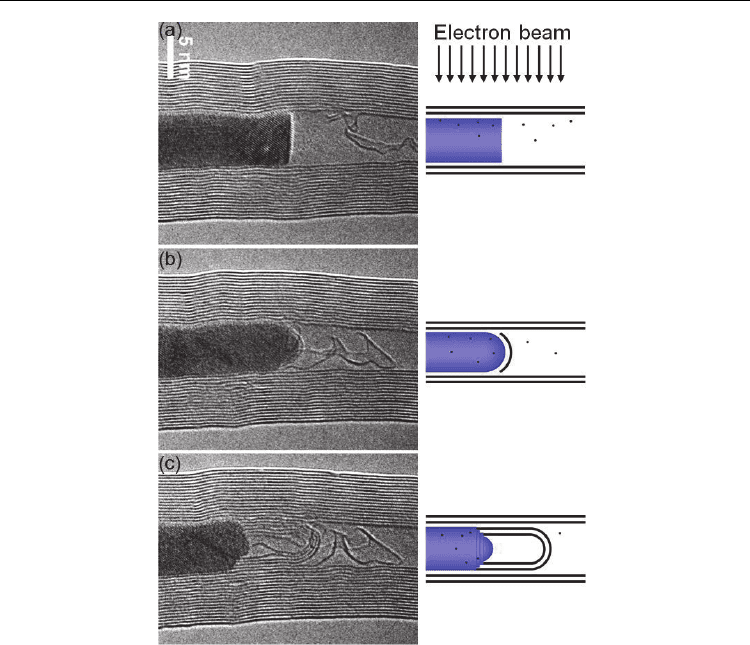
Carbon Nanotubes - Synthesis, Characterization, Applications
162
Fig. 9. In-situ observation of CNT growth under HRTEM. (a) Electron beam knocks some
carbon atoms from the MWCNT side walls into the encapsulated metal cluster. (b) The
metal cluster reshapes its flat cross section into a convex dome and a carbon cap appears
over the dome. (c) At the base of the metal dome, atomic steps develop and new MWCNTs
emerge coaxial to the original MWCNT. (Image courtesy: M. Terrones)
3.3 Chemical state of the catalyst
Another frequently debated point in the CNT growth mechanism is about the chemical state
of the active catalyst. Most common concept is that the starting catalyst material (pre-
deposited on substrates) is usually in oxide form. Even if we deposit fresh metal
nanoparticles on a substrate, the nanoparticles get quickly oxidized when exposed to
oxygen during the substrate transfer to the CVD reactor. During CVD, hydrogen gas is
supplied to reduce the metal oxide into pure metal upon which hydrocarbon decomposition
and subsequent diffusion leads to the CNT growth. Even when no hydrogen is supplied
externally, the hydrogen atoms liberated from the hydrocarbon decomposition on the
catalyst surface are likely to serve the same. However, there are many conflicting reports
right from the early-stage CVD experiments. Baker and many others proposed that pure
metal is the active catalyst (Baker et al., 1982; Yang et al., 1986), while Endo and many others
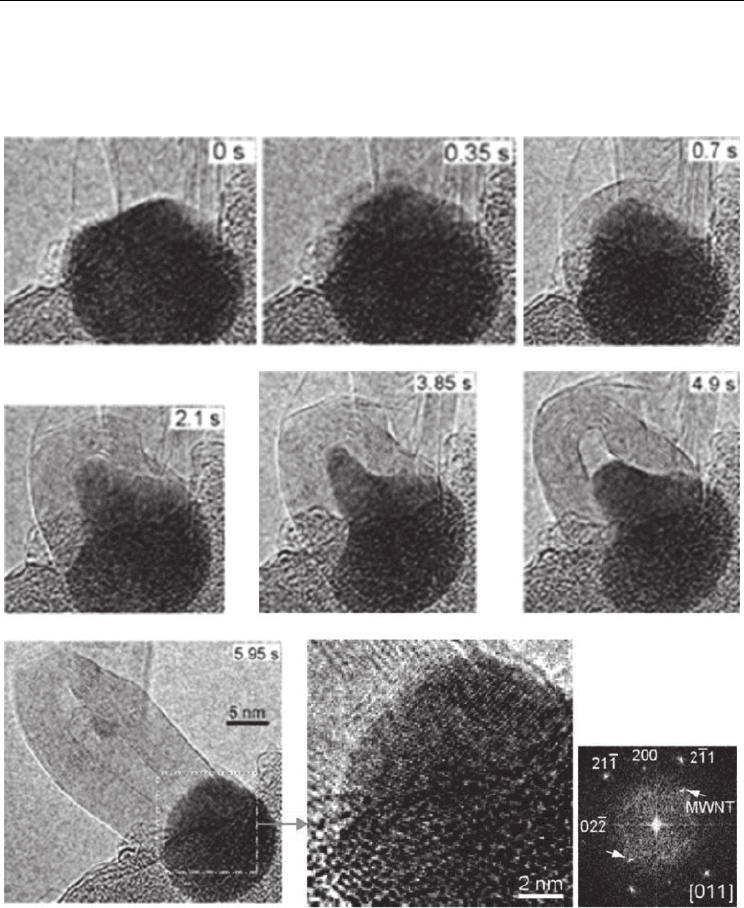
Carbon Nanotube Synthesis and Growth Mechanism
163
detected the encapsulated particles (in the CNTs) to be iron carbide (Oberlin et al., 1976;
Ducati et al., 2004).
Fig. 10. In-situ TEM observation of MWCNT nucleation and growth as a consequence of
acetylene decomposition on iron catalyst at 600°C. Initially, graphene layers appear around
the metal cluster. Subsequently, the metal cluster assumes a conical shape, elongates
upward (expelling a CNT), and finally, comes back to round shape. Fourier transform of the
enlarged image of the metal cluster at 5.96s suggests it to be Fe
3
C. (Yoshida et al., (2008).
Nano Lett. 8, 2082-2086. © American Chemical Society)
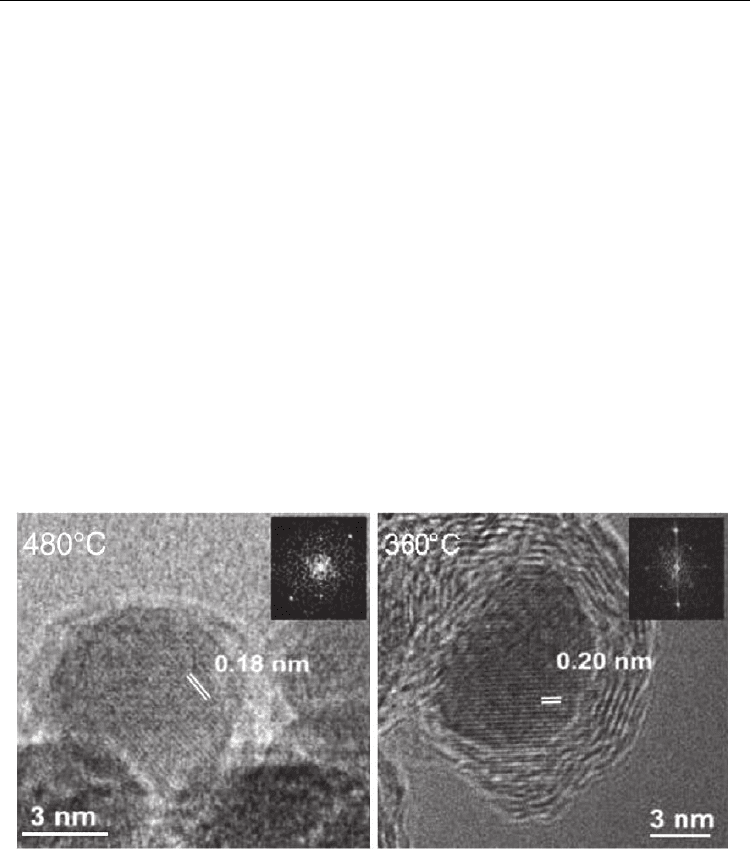
Carbon Nanotubes - Synthesis, Characterization, Applications
164
In 2008, Yoshida et al. performed atomic-scale in-situ observation of acetylene
decomposition on Fe catalyst at 600°C and 10
-2
torr. Both SWCNT and MWCNT were clearly
observed to be growing from metal particles rooted on the substrate (base-growth model).
Electron diffraction analysis of the metal clusters in each frame was reported to match with
that of iron carbide in cementite (Fe
3
C) form (Fig. 10). Accordingly, the authors concluded
that the active catalyst was in ‘fluctuating solid state’ of ‘iron carbide’; the carbon diffusion
was volumetric; and all layers of the MWCNTs grew up simultaneously, at the same growth
rate.
However, Wirth et al. (2009), based on their in-situ electron microscopy and XPS analyses,
emphatically advocate that the catalyst exists in pure metallic form: right from the CNT
nucleation to the growth termination (Fig. 11). When the CNT growth ceases due to catalyst
poisoning with excess carbon, that supersaturated metal-carbon assembly crystallizes in
carbide form upon cooling. Confusion persists because lattice constants of pure metal and
their carbide or oxide are very close. For instance, 2Å reflection is possible from fcc Ni(111)
or Ni
3
C(113) or Ni
2
O
3
(200). Moreover, for ‘nano’ particles, some distortion in the lattice
constants is expected due to the small-size effect. The authors also suggest that the catalyst
particle undergoes severe mechanical re-shaping during the tip growth of multi-wall
nanotubes. This looks like the metal is in liquid state. However, this shape distortion occurs
due to relative displacement of different atomic layers (in solid state) due to the large forces
exerted by the surrounding CNT in the growth stage.
Fig. 11. In-situ TEM images of CNT growth from acetylene decomposition on Ni particles at
480 °C and 360°C. Clear observation of lattice planes suggests the metal to be in crystalline
(solid) state. (Wirth et al., 2009. Diamond & Related Mater. 18, 940-945. © Elsevier Science)
Among the latest literature, Chen et al. (2011) performed in-situ resonance Raman
spectroscopy and XRD photoelectron spectroscopy of ethanol CVD directly on SiO
2
nanoparticles without any metal. Their results suggest that, during the CVD, SiO
2
does not
form any SiC phase and the SWCNT nucleation and growth occur by carbon diffusion on
solid SiO
2
particles, following a vapor-solid-solid (VSS) model, instead of the conventional
vapor-liquid-solid (VLS) model (Fig. 12).
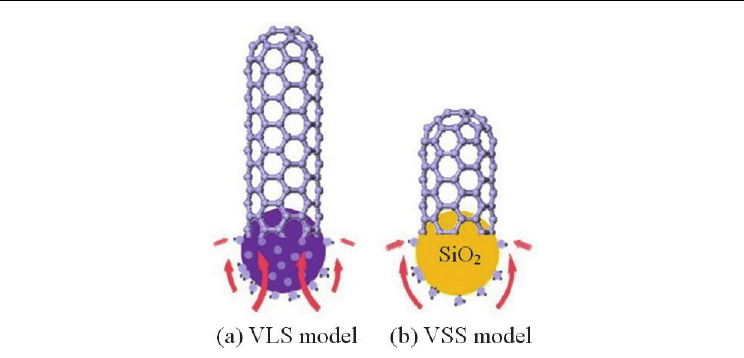
Carbon Nanotube Synthesis and Growth Mechanism
165
Fig. 12. (a) VLS model for SWCNT growth from a metal nanoparticle: volume diffusion of C
atoms (vapor) in metal (liquid) to crystallize a CNT (solid). (b) VSS model for the SWCNT
growth from an SiO
2
nanoparticle: surface diffusion of carbon atoms (vapor) on SiO
2
(solid)
resulting in a CNT (solid). (Chen et al., 2011. Carbon 49, 3316-3324. © Elsevier Science)
These diversities of observation unambiguously reflect that we have not matured enough to
understand the world inside the nanotubes. Hence more research is required to establish a
concrete growth mechanism. Then only we would be able to make CNTs of specific
properties, and in turn, CNT would be able to fulfill the expectations and needs of the
society.
4. Existing challenges and future directions
In the foregoing sections, we raised several questions on the roles of precursor, catalyst,
catalyst support and growth mechanism, and indicated possible directions. In addition to
those basic issues, other growth-related challenges are briefly outlined below.
1. Researchers have succeeded in minimizing the diameter distribution of SWCNTs up to
some extent. However, synthesis of SWCNTs of a given diameter is yet to be achieved.
It would be possible only when we have the catalyst particles all of exactly the same
diameter (say, 0.5 nm).
2. Chirality control is even more challenging. Re-growth from ordered arrays of open-
ended SWCNTs may help up to some extent. Alternatively, we have to develop proper
separation methods that could first sort out CNTs according to metallic or
semiconducting tubes and then select tubes of specific chirality.
3. In MWCNTs, control on the number of walls is another big challenge. Synthesis of thin
MWCNTs (3–6 walls) is a better choice than thick MWCNTs.
4. Growth of isolated CNTs has not yet reached a mature stage. There are indications that
even a single CNT does not possess the same diameter and chirality over the entire
length. How can we solve it?
5. Researchers have succeeded in growing CNTs from almost all metals. However, we do
not know how different metals affect the physical, chemical, electronic and optical and
magnetic properties of as-grown CNTs. If we could discover any correlation between

Carbon Nanotubes - Synthesis, Characterization, Applications
166
the type of the metal used and the property of the CNT grown, we would be able to
grow CNTs of selective properties.
6. What is/are the determining steps in CNT nucleation and growth? Having known
these steps, the CNT growth rate could be increased for mass production.
7. The exact role of H
2
, O
2
and H
2
O in CNT growth is yet to be clarified. Simultaneous
presence of reducing as well as oxidizing agents in the reaction zone makes it
ambiguous whether amorphous carbon is etched by atomic hydrogen, oxygen or water.
Are they really essential?
8. Researchers have succeeded in bringing down the CNT growth temperature to ~400°C
in low-pressure CVD. However, low-pressure CVD greatly reduces the growth rate and
yield. Low-temperature CNT growth must be devised at atmospheric pressure for high
yields of CNTs.
9. Many technological applications are looking for room-temperature CNT growth which
is still a dream, so far as thermal CVD is concerned.
10. Mass-produced CNTs usually contain catalyst particles or support materials as
impurity. Post-deposition purification greatly reduces the CNT quality and final
output.
11. CVD-grown CNTs (especially low-temperature MWCNTs) have poor crystallinity.
With a suitable combination of different catalysts, it should be possible to get better-
crystallinity CNTs.
12. Recent metal-free oxygen-assisted CNT growth is a breakthrough. It must be scaled up
to mass production of high-purity CNTs.
13. Carbon-metal phase diagram needs to be reconstructed, especially for 1–5 nm range,
relevant to CNT growth.
14. All extraordinary properties of CNTs are predicted for atomically-perfect CNTs. To
make those predictions true, it is of prime importance to develop new techniques to
monitor and remove defects during the growth.
15. Lack of the quality control and assessment of the CNTs synthesized by different groups
by different methods does not allow us to get the correct product details. Analytical
sampling of CNTs obtained from different sources at an authorized standard laboratory
would reveal exact merits and demerits of different techniques, which would in turn
help us explore combinations of techniques toward high-yield, high-purity and low-
cost mass production.
5. Conclusion
As we have seen in the foregoing sections, despite extensive progress over the years, there
are many basic issues concerning the CNT growth mechanism which are still not clear.
Contradictory observations of CNT growth under electron microscopy by different groups
suggest that the mechanism is extremely sensitive to each parameter such as carbon
precursor, metal catalyst, particle size, temperature, pressure. Even a minor change in any of
these parameters leads the growth in critically different directions. Catalysis is the main
stem of CVD-CNT technique; and it seems that we have not yet utilised the best of catalysis
in this field. New nano-catalyst materials are needed to be developed and investigated in
more detail. In principle, with the use of a suitable catalyst, the CVD temperature can be
brought down to room temperature. By identifying the growth-limiting steps it should be
possible to control the diameter and chirality of the resulting CNTs. To comply with the
